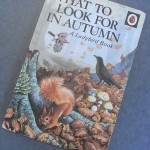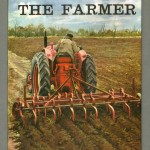As the exhibition opening draws closer, our exploration of the biographies of individual copies of books from the What to Look For series continues. Although the copy pictured below is not a first edition but a later version and is arguably far less ‘collectible’ by traditioanl standards, I think there is little chance that this particular volume will ever reach the secondhand book market. It will certainly not do so in the lifetime of its current owner, for whom it is of special importance.

This later edition of the ‘Autumn’ book has been lent by Kelly Borlase-Hendry and her husband Piran Borlase-Hendry, who has had it since he was a child.
Indeed, the book has come to us via Kelly Borlase-Hendry who works as a Student Financial Support Team Leader within the University of Reading. It belongs to her husband Piran Borlase-Hendry who remembers the What to Look For series being his favourite books when he was younger, so much so that they were the only volumes that he kept from his childhood.
This narrative doesn’t differ enormously from the other familial stories I have already recounted. Someone owned the book as a child and liked it enough to hang onto it into adulthood. However, there is a further twist to this particular example. Piran wanted me to point out that not only that he is a graduate of Rural Resource Management here at the University of Reading (and therefore has his own institutional connection) but that he is now working as an Ecologist, a career trajectory that has much to do with his love of these books in his youth. Indeed, as his wife Kelly told me, Piran thinks that ‘his love of the countryside stems from these books.’
For me at least and for our purposes in this part of the exhibition and wider project, this a tremdously powerful idea. It is one thing for us to be asking quite simply how people respond to an image from the Autumn volume or what they think of the book and the text now but to know it had such a profound impact on someone’s life, and that these four small books were capable of influencing what degree and subsequent career somebody chose to pursue is a step on from exploring the possible meaning of marginalia and old sticky tape marks.
Do you have a similar story to tell about one of these four books, or perhaps regarding the infleunce of Ladybird books on subsequent life choices more generally? If the What to look For books could inspire someone to a career in ecology, a type of job that was markedly less common when they were first published then there must be people out there whose subsequent paths were determined by the more straightforwardly career-oriented volumes produced through Ladybird’s People at Work series.

First published in 1963, ‘The Farmer’ by I and J Havenand gave a detailed account of farming at this time and what it entailed. It was one of Ladybird’s ‘People at Work’ series. A slightly later edition may be seen in the exhibition.
For example, the very first two of these being Vera Southgate’s The Fireman (1962) and The Policeman (1962). This is to say nothing of I and J Havenand’s The Farmer (1963), which is arguably more relevant here, as well as the nurses, builders, postmen, miners, and others whose lives might have been shaped by these formative and informative books.
Thanks to Piran and Kelly for sharing the story behind the copy they have kindly lent.
